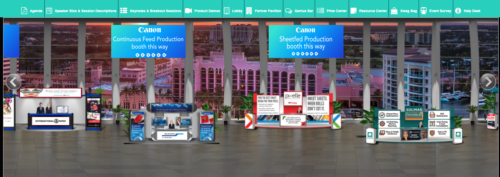How many virtual conferences have you been a part of since the beginning of March? Not the usual array of webinars, but true virtual conferences? Zoom, Go-to-Webinar, Go-To-Meeting, On24, VFairs, WebEx, and the emerging platforms like WebinarJam and Remo are just a few of the platforms you may have experienced. Each one intends to make it easier for us to engage with one another while we’re avoiding large group events, but the platform is only one factor in the virtual conference experience. Programming and scheduling, as well as the presentation model make a difference to attendees. Is everyone paying attention?
The two most recent for Inkjet Insight aficionados were the Inkjet Summit, originally scheduled for Austin, Texas, and the thINK Forum, originally scheduled for Boca Raton, Florida. To carry as virtual events each had to rearrange their plans. Each selected different platforms and approaches, and the experiences were very different.
Before the deep dives, remember that many of the conferences were caught in a bind as it became clear that meeting in person was no longer possible. Months of planning go into live events beyond the logistics and agendas. With the move to virtual, there were a host of new considerations, including date changes, how many hours to operate, and what platform to use. Without knowing if we would all be starting to go back to work or suffering online fatigue, organizers had to devise plans to keep everyone engaged while meeting their conference brief.
With that preamble, the Inkjet Summit and thINK Forum took different paths. It’s worth exploring them and taking away some lessons.

Inkjet Summit is a long-running event designed to introduce the inkjet-curious to an array of solution providers, both hardware and software. The live meetings have always been built to foster networking, camaraderie, and education, providing ample time for personal meetings between vendors and the invited guests. While it has been a Florida event since inception, the event had grown enough to warrant a new location, hence the planned move to Austin.
While the organizers hoped that the event might go on, it became clear early in the summer that the combination of restrictions on travel combined with limitations at the resort would make the event impossible to facilitate in person. To move to an online conference required rethinking every facet of the conference promise. Delivering an equivalent experience to both the vendors who foot the bill and the invitees needed options for fostering the one-to-one meetings both parties expect.
The next big change, after the decision to go virtual, was who could attend. Inkjet Summit has always had an exclusive invitation list, but this year the summit was opened to a wider range of attendees to provide more opportunity for the vendors and to spread the education.

The Inkjet Summit tried hard. They asked each of the content providers to prerecord their sessions and set up systems to permit individual meetings. They reset the schedule to take place over several days, limiting the number of online hours on each day. They advertised an easy-to-access and easy-to-navigate experience. There were some hits and misses.
The keynotes and general sessions provided the education Inkjet Summit is known for, as did most of the breakout sessions. (See Elizabeth Gooding’s post on the excellent keynote from Tim Curtis of CohereOne for example.) The case study sessions were inconsistent in their presentation and approach. The mission of the case study is to feature the customer and tell their story. Some vendors did this well, showing the value through the customer’s eyes. Those who came with fresh stories provided an excellent experience. However, some vendors resorted to the same stories they have been telling at every event this year (and for some, last year) and brought precious little new information to the table. Some spent so much time talking about themselves that the featured customer seemed to be an afterthought.
To be fair, this is sometimes the case at the live conferences and something that IJS has limited control over, but when the event goes online, the sins become more obvious. In surfing the case study sessions across the agenda, it seemed that some curation was in order on the part of the vendors and the conference organizers.
The place where the Inkjet Summit faced the biggest challenge was in the platform and how it attempted to enable one-to-one meetings. A survey of vendors revealed that some managed to schedule meetings they felt valuable, but more indicated that they resorted to setting up meetings outside of the platform.
The take-away from the Inkjet Summit was that there was good information shared, but the platform did not provide the best experience.
The team running thINK Forum took a similar approach but excelled in execution. The education on the schedule was well thought out, set for one day with multiple tracks. Sessions were prerecorded and reviewed by the team to ensure they were on message and that the recordings were good quality. Many of the sessions had several rehearsals prior to recording to ensure that they met the organizers expectations, and presenters were asked to be present in the chat room for their sessions to encourage live interaction.
Another technique that set it apart was the approach to the vendor exhibit area. They gamified the event so that attendees earned points for visiting the vendors and downloading collateral. The Swag Bag collected the material, and then you could email it to yourself. (Would have been lovely if it created a ZIP file!) Vendors were encouraged to be present in the chat room for their booth for the duration of the conference and could load video content to enhance the experience.
While there were occasional technical issues, as with all virtual conferences, the chat rooms and ability to interact with the vendors during the day made the available customer experience one of the better executions of the current virtual conference season. It should be noted that pulling this off required a huge effort from the Canon marketing team, however; they also had the support of an outside conference team. In fact, Eric Hawkinson left his position as Vice President of Marketing for Canon Solutions America in June to become a partner with Innovatis Group which provides the infrastructure for the thINK Forum and deserves a lot of the credit for the technology selection and logistics.
As a speaker and attendee at both events, the thINK Forum platform was a clear winner. It proved easy to navigate and to engage during sessions. There were vibrant conversations going on in the chat rooms, and the attention to detail in curating the content paid off for attendees.
The take-away from the virtual conference season so far? Hosts need to think through their platforms carefully. While Zoom, WebEx, and the others have been part of our webinar lives for years, staging a virtual conference is not the same as a webinar. A virtual event needs to be produced in the context of online fatigue and an understanding that there are many pulls on everyone’s time. If the platform is difficult, attendees will leave. If the content is not top-of-the-line, attendees will leave. If the experience doesn’t provide value, attendees will leave. Don’t be the organization that earns the reputation for poor execution. There are plenty of people who know how to run a successful online event!
Remember, there are a million questions in inkjet city! Have a question for Pat? Get in touch.

